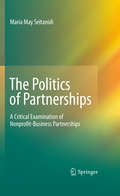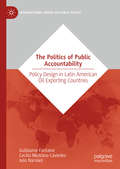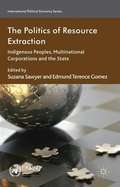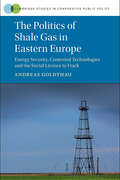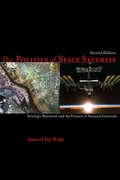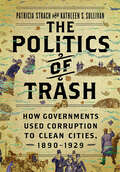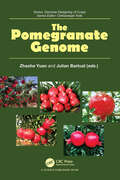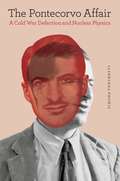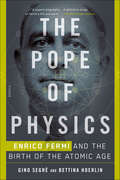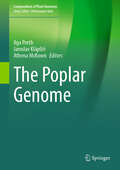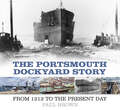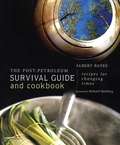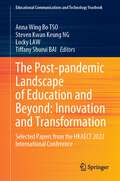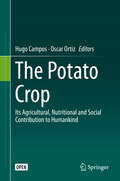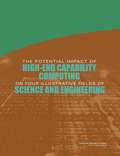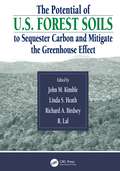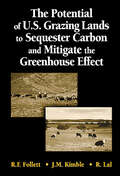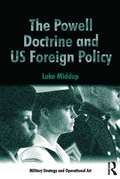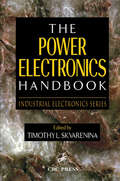- Table View
- List View
The Politics of Partnerships: A Critical Examination of Nonprofit-Business Partnerships
by Maria May SeitanidiThe widespread partnering phenomenon in the US and the UK spurred a significant amount of literature focusing on its strategic use. The Politics of Partnerships diverges by examining if partnerships can deliver benefits that extend beyond the organisational to the societal level resulting from the intentional combined efforts of the partners.
The Politics of Public Accountability: Policy Design in Latin American Oil Exporting Countries (International Series on Public Policy)
by Guillaume Fontaine Iván Narváez Cecilia Medrano CaviedesThis book seeks to consistently explain the role of ideas and institutions in policy outcomes, and addresses the problem of how resource nationalism causes a deficit of public accountability in oil producing countries from Latin America and the Caribbean. The authors present a causal mechanism linking ideas and policy outcomes through institutional arrangements, focusing on policy design to describe the role of instruments selection and combination in improving or reducing public accountability through agenda setting, policy formulation, cross-sectorial coordination and political interplays.
The Politics of Resource Extraction
by Suzana Sawyer Edmund Terence GomezInternational institutions (United Nations, World Bank) and multinational companies have voiced concern over the adverse impact of resource extraction activities on the livelihood of indigenous communities. This volume examines mega resource extraction projects in Australia, Bolivia, Canada, Chad, Cameroon, India, Nigeria, Peru, the Philippines.
The Politics of Shale Gas in Eastern Europe: Energy Security, Contested Technologies and the Social License to Frack (Cambridge Studies in Comparative Public Policy)
by Andreas GoldthauFracking is a novel but contested energy technology – so what makes some countries embrace it while others reject it? This book argues that the reason for policy divergence lies in procedures and processes, stakeholder inclusion and whether a strong narrative underpins governmental policies. Based on a large set of primary data gathered in Poland, Bulgaria and Romania, it explores shale gas policies in Central Eastern Europe (a region strongly dependent on Russian gas imports) to unveil the importance of policy regimes for creating a ‘social licence’ for fracking. Its findings suggest that technology transfer does not happen in a vacuum, but is subject to close mutual interaction with political, economic and social forces; and that national energy policy is a matter not of ‘objective’ policy imperatives, such as Russian import dependence, but of complex domestic dynamics pertaining to institutional procedures and processes, and winners and losers.
The Politics of Space Security
by James Clay MoltzMoltz (national security affairs, US Naval Postgraduate School) traces military space developments from 1957 to the present--including weapons tests and deployments, arms control treaties, and less formal cooperative agreements--in order to understand underlying causes and possible future developments relevant to the policy debate over military uses of space and defense of space-based assets by the United States. After discussing the historical and conceptual background, he focuses on how competition between the Soviet Union and the United States grew more limited following an initially hostile, open-ended, and military-led space programs as both sides accepted mutual constraints on deployable weapons in return for safe access to space for other uses. He next examines the period between the collapse of the Soviet Union and 2001, noting that the US generally maintained self-restraint and cooperative space relations even in the face of the decline of Russian space capabilities. Finally, he looks at the very different dynamics under the Bush administrations and analyzes the underlying factors for the change and concludes with a discussion of possible space futures, ranging from atomized and state-centric to highly integrated and transnational. Annotation ©2008 Book News, Inc. , Portland, OR (booknews. com)
The Politics of Technological Progress: Parties, Time Horizons and Long-term Economic Development
by Joel W. Simmons"Why are some countries richer than others and why do some economies grow more rapidly? The Politics of Technological Progress answers these vital questions by highlighting the importance of technological progress for sustained economic development. The author also explains why some countries exhibit faster technological progress than others. Armed with a wealth of cross-national empirical evidence, Professor Simmons stresses the importance of properly constructed political parties for establishing an environment conducive to technological progress. 'Well-institutionalized' ruling parties are essential for technological progress, he argues, because only in such parties are time horizons long enough for governments to accept the deferred returns that are an inherent feature of government efforts to encourage innovation and technology adoption in the economy"--
The Politics of Technology in Africa
by Iginio GagliardoneAs more Africans get online, information and communication technologies (ICTs) are increasingly hailed for their transformative potential. Yet, the fascination for the possibilities of promoting more inclusive forms of development in the information age have obfuscated the reality of the complex negotiations among political and economic actors who are seeking to use technology in their competition for power. Building on over ten years of research in Ethiopia, Iginio Gagliardone investigates the relationship between politics, development, and technological adoption in Africa's second most populous country and its largest recipient of development aid. The emphasis the book places on the 'technopolitics' of ICTs, and on their ability to embody and enact political goals, offers a strong and empirically grounded counter-argument to prevalent approaches to the study of technology and development that can be applied to other cases in Africa and beyond.
The Politics of Trash: How Governments Used Corruption to Clean Cities, 1890–1929
by Kathleen S. Sullivan Patricia StrachThe Politics of Trash explains how municipal trash collection solved odorous urban problems using nongovernmental and often unseemly means. Focusing on the persistent problems of filth and the frustration of generations of reformers unable to clean their cities, Patricia Strach and Kathleen S. Sullivan tell a story of dirty politics and administrative innovation that made rapidly expanding American cities livable. The solutions that professionals recommended to rid cities of overflowing waste cans, litter-filled privies, and animal carcasses were largely ignored by city governments. When the efforts of sanitarians, engineers, and reformers failed, public officials turned to the habits and tools of corruption as well as to gender and racial hierarchies.Corruption often provided the political will for public officials to establish garbage collection programs. Effective waste collection involves translating municipal imperatives into new habits and arrangements in homes and other private spaces. To change domestic habits, officials relied on gender hierarchy to make the women of the white, middle-class households in charge of sanitation. When public and private trash cans overflowed, racial and ethnic prejudices were harnessed to single out scavengers, garbage collectors, and neighborhoods by race. These early informal efforts were slowly incorporated into formal administrative processes that created the public-private sanitation systems that prevail in most American cities today. The Politics of Trash locates these hidden resources of governments to challenge presumptions about the formal mechanisms of governing and recovers the presence of residents at the margins, whose experiences can be as overlooked as garbage collection itself. This consideration of municipal garbage collection reveals how political development often relies on undemocratic means with long-term implications for further inequality. Focusing on the resources that cleaned American cities also shows the tenuous connection between political development and modernization.
The Pollution Biology of Aquatic Oligochaetes
by Trefor B. Reynoldson Pilar RodriguezIn aquatic ecosystems, the oligochaetes are often a major component of the community. Their relevance in sediment quality assessment is largely related to their benthic and detritivorous life habit. In this book, we aim to present the state of the art of Pollution Biology using oligochaete worms in laboratory and field studies. Future research will require the combination of a variety of methodological approaches and the integration of the resulting information, avoiding fragmented and often conflicting visions of the relationships of the species with their environment. Current approaches to ecotoxicology and bioaccumulation using ecological risk assessment provide the opportunity to relate community studies with probability of effects. This book addresses three main themes: Ecological and Field Studies using the composition and structure of oligochaete communities, Toxicology and Laboratory Studies, and Bioaccumulation and Trophic Transfer Studies. Two appendices list values of toxicological parameters (LC50, EC50) and several bioaccumulation variables (bioaccumulation factors, biological half-life, toxicokinetic coefficients, and critical body residues) for different oligochaete species. Additional information is provided on Methodological Issues and on the Taxonomy of several oligochaete families, with information on the most recent taxonomic debates. Each chapter includes a critical view, based on the authors' experience, of a number of current issues which have been raised in the literature.
The Pomegranate Genome (Genome Designing of Crops)
by Zhaohe Yuan Julian BartualThe volume is a comprehensive resource for researchers, scholars, and enthusiasts in the field of pomegranate research. It delves into various aspects of the pomegranate crop, providing an extensive coverage of its botany, taxonomy, germplasm conservation and utilization, genome, and functional genomics. The work provides a detailed understanding of the pomegranate's genetic makeup and its potential applications. The research presented in the book focuses on the identification and analysis of key genes and gene families of pomegranates, and sheds light on their functions and contributions to the plant's growth and development. By uncovering these genetic insights, researchers can further explore the plant's potential for agricultural improvement and its adaptation to various environmental conditions. Moreover, the book goes beyond genetic analysis and delves into the conservation and utilization of pomegranate germplasm. It provides insights into the preservation and sustainable management of the plant's genetic resources, ensuring their availability for future generations. This aspect of the book highlights the importance of maintaining biodiversity and the potential benefits it brings to agriculture and food security. It also explores a review of pomegranate genomes, multiomics, and chloroplast genome. By examining these aspects, researchers can gain a deeper understanding of the plant's molecular mechanisms, metabolic pathways, and evolutionary history. This knowledge contributes to the development of improved breeding strategies, disease resistance, and the enhancement of desirable traits in pomegranate cultivars.In conclusion, the serves as a reference for anyone interested in the botany and genetics of this unique fruit species. Its comprehensive coverage of various aspects of pomegranate research, from its genetic composition to its functional genomics and germplasm conservation, makes it a valuable tool for advancing our understanding and utilization of this remarkable crop.
The Pontecorvo Affair: A Cold War Defection and Nuclear Physics
by Simone TurchettiIn the fall of 1950, newspapers around the world reported that the Italian-born nuclear physicist Bruno Pontecorvo and his family had mysteriously disappeared while returning to Britain from a holiday trip. Because Pontecorvo was known to be an expert working for the UK Atomic Energy Research Establishment, this raised immediate concern for the safety of atomic secrets, especially when it became known in the following months that he had defected to the Soviet Union. Was Pontecorvo a spy? Did he know and pass sensitive information about the bomb to Soviet experts? At the time, nuclear scientists, security personnel, Western government officials, and journalists assessed the case, but their efforts were inconclusive and speculations quickly turned to silence. In the years since, some have downplayed Pontecorvo's knowledge of atomic weaponry, while others have claimed him as part of a spy ring that infiltrated the Manhattan Project. The Pontecorvo Affair draws from newly disclosed sources to challenge previous attempts to solve the case, offering a balanced and well-documented account of Pontecorvo, his activities, and his possible motivations for defecting. Along the way, Simone Turchetti reconsiders the place of nuclear physics and nuclear physicists in the twentieth century and reveals that as the discipline's promise of military and industrial uses came to the fore, so did the enforcement of new secrecy provisions on the few experts in the world specializing in its application.
The Pontecorvo Affair: A Cold War Defection and Nuclear Physics
by Simone TurchettiIn the fall of 1950, newspapers around the world reported that the Italian-born nuclear physicist Bruno Pontecorvo and his family had mysteriously disappeared while returning to Britain from a holiday trip. Because Pontecorvo was known to be an expert working for the UK Atomic Energy Research Establishment, this raised immediate concern for the safety of atomic secrets, especially when it became known in the following months that he had defected to the Soviet Union. Was Pontecorvo a spy? Did he know and pass sensitive information about the bomb to Soviet experts? At the time, nuclear scientists, security personnel, Western government officials, and journalists assessed the case, but their efforts were inconclusive and speculations quickly turned to silence. In the years since, some have downplayed Pontecorvo’s knowledge of atomic weaponry, while others have claimed him as part of a spy ring that infiltrated the Manhattan Project. The Pontecorvo Affair draws from newly disclosed sources to challenge previous attempts to solve the case, offering a balanced and well-documented account of Pontecorvo, his activities, and his possible motivations for defecting. Along the way, Simone Turchetti reconsiders the place of nuclear physics and nuclear physicists in the twentieth century and reveals that as the discipline’s promise of military and industrial uses came to the fore, so did the enforcement of new secrecy provisions on the few experts in the world specializing in its application.
The Pope of Physics: Enrico Fermi and the Birth of the Atomic Age
by Gino Segrè Bettina HoerlinOne of Booklist’s Top 10 Science Books of the Year: “A superb biography . . . A definite study of Fermi’s life and work.” —The Wall Street JournalA Bloomberg Best Book of the YearA Finalist for Physics World’s Book of the YearA New York Times Book Review Editor’s ChoiceNobel Prize winner Enrico Fermi is unquestionably among the world’s greatest physicists, the most famous Italian scientist since Galileo. Called “the Pope” by his peers, he was regarded as infallible in his instincts and research. His discoveries changed our world; they led to weapons of mass destruction and, conversely, to life-saving medical interventions.This unassuming man struggled with issues relevant today, such as the threat of nuclear annihilation and the relationship of science to politics. Fleeing fascism and anti-Semitism, Fermi became a leading figure in America’s most secret project: building the atomic bomb. The last physicist who mastered all branches of the discipline, Fermi was a rare mixture of theorist and experimentalist. His rich legacy encompasses key advances in fields as diverse as cosmic rays, nuclear technology, and early computers.The Pope of Physics by Gino Segré and Bettina Hoerlin is “an engaging portrait of a man with boundless curiosity who delighted in his work” and an “entertaining and accessible biography of a scientist who deserves to be better understood” (Publishers Weekly, starred review).“Intimate, often charming stories of the famed physicist’s personal life . . . a book that’s both intelligent and extremely engaging.” —The Washington Post
The Poplar Genome (Compendium of Plant Genomes)
by Ilga Porth Jaroslav Klápště Athena McKownThis book is the first comprehensive compilation of research on state‐of‐the-art genomics on the most advanced model tree species including genome assemblies, insights into genomic structural features and methylation patterns, whole‐genome resources used for population genomics and adaptation to climate, enabled breeding vs. classical genetics and traditional breeding, comparative genomics, and elucidations on functional genomics. The latest developments in the genomics of wood formation are particularly highlighted. Altogether, the book contains over 300 pages in over 15 chapters authored by globally reputed experts in the relevant fields of this tree crop’s genomics research. This book is useful for students, teachers, and scientists in academia and governmental or private tree improvement agencies or companies interested in genetics, pathology, entomology, physiology, molecular genetics and breeding, in vitro culture and genetic engineering, land restoration, and agroforestry solutions.
The Portal to Lean Production: Principles and Practices for Doing More with Less (Resource Management)
by John Nicholas Avi SoniThe Portal to Lean Production: Principles and Practices for Doing More with Less describes the steps, difficulties, and rewards of implementing lean production. The book moves beyond concepts to address practical matters. The authors provide enough information for you to begin implementing lean production within your organization.This book
The Portsmouth Dockyard Story: From 1212 to the Present Day
by Paul BrownFrom muddy creek to naval-industrial powerhouse; from constructing wooden walls to building Dreadnoughts; from maintaining King John’s galleys to servicing the enormous new Queen Elizabeth-class aircraft carriers: this is the story of Portsmouth Dockyard. Respected maritime historian Paul Brown’s unique 800-year history of what was once the largest industrial organisation in the world is a combination of extensive original research and stunning images. The most comprehensive history of the dockyard to date, it is sure to become the definitive work on this important heritage site and modern naval base.
The Positive Side of Occupational Health Psychology
by Maria Karanika-Murray Marit Christensen Per Øystein SaksvikThis book serves as an introduction to the Nordic approach to Occupational Health Psychology and illustrates how this perspective can be transferred to a global audience. It discusses a joining of attitudes from Positive Psychology accompanied by experiences drawn from the Nordic work/life context. Over the decades, Nordic countries have gathered a great deal of experience on the meaningfulness of work, work engagement, presenteeism, absenteeism, job crafting, work family balance, intervention and reorganization. These experiences are explained and offered as a different approach to Occupational Health Psychology, while avoiding the more traditional detrimental topics such as stress, conflict burnout and poor well-being. Instead the authors discuss subjects such as engagement, healthy change, prosperity and welfare and are applied to the current ideas on Occupational Health Science. This book shows that using interdisciplinary observations can help our understanding of modern worker health. It offers gives readers an opportunity to consider how a combination of good work and good health can be stimulated in theory and in practice.
The Post-Petroleum Survival Guide and Cookbook
by Albert BatesA world beyond petroleum needn't be a scary proposition - it can be something to relish. As we move from a global culture addicted to cheap, abundant petroleum to a culture of compelled conservation, The Post-Petroleum Survival Guide and Cookbook provides useful, practical advice for preparing your family and community to make the transition.
The Post-pandemic Landscape of Education and Beyond: Selected Papers from the HKAECT 2022 International Conference (Educational Communications and Technology Yearbook)
by Anna Wing Bo TSO Steven Kwan Keung NG Locky Law Tiffany Shurui BaiWith the purpose of exploring the critical possibilities offered by the global crisis of coronavirus pandemic, this volume presents the collected works of scholars, educators and practitioners worldwide, bringing to the readers a broad array of perspectives on how COVID-19 inspires us to rethink, redefine, and make sense of the theoretical and pedagogical approaches that can be applied in various educational contexts. Part One of the book provides an insightful exploration of the technology-mediated innovations used in English language learning and teaching. Part Two reflects on the online learning experiences of students, as well as the teachers’ strategies to cope with changes as the COVID-19 pandemic unleashed unprecedented disruptions in class. Part Three looks into a range of case studies regarding the digital divide, cross-border schooling, cyberbullying, and cross-disciplinary skill training in the post-pandemic workplace, highlighting the importance of creating a positive learning environment. Part Four draws on the observations and experiences of frontline teachers, to examine ways to optimize the digital learning experiences of students in and outside the classroom. This volume will be a useful reference for scholars in Education, Communication, Applied Linguistics, Social Work, and Positive Psychology.
The Potato Crop: Its Agricultural, Nutritional and Social Contribution to Humankind
by Hugo Campos Oscar OrtizThis book is open access under a CC BY 4.0 license. This book provides a fresh, updated and science-based perspective on the current status and prospects of the diverse array of topics related to the potato, and was written by distinguished scientists with hands-on global experience in research aspects related to potato. The potato is the third most important global food crop in terms of consumption. Being the only vegetatively propagated species among the world’s main five staple crops creates both issues and opportunities for the potato: on the one hand, this constrains the speed of its geographic expansion and its options for international commercialization and distribution when compared with commodity crops such as maize, wheat or rice. On the other, it provides an effective insulation against speculation and unforeseen spikes in commodity prices, since the potato does not represent a good traded on global markets. These two factors highlight the underappreciated and underrated role of the potato as a dependable nutrition security crop, one that can mitigate turmoil in world food supply and demand and political instability in some developing countries. Increasingly, the global role of the potato has expanded from a profitable crop in developing countries to a crop providing income and nutrition security in developing ones. This book will appeal to academics and students of crop sciences, but also policy makers and other stakeholders involved in the potato and its contribution to humankind’s food security.
The Potential Impact Of High-end Capability Computing On Four Illustrative Fields Of Science And Engineering
by National Research Council of the National AcademiesMany federal funding requests for more advanced computer resources assume implicitly that greater computing power creates opportunities for advancement in science and engineering. This has often been a good assumption. Given stringent pressures on the federal budget, the White House Office of Management and Budget (OMB) and Office of Science and Technology Policy (OSTP) are seeking an improved approach to the formulation and review of requests from the agencies for new computing funds. This book examines, for four illustrative fields of science and engineering, how one can start with an understanding of their major challenges and discern how progress against those challenges depends on high-end capability computing (HECC). The four fields covered are: atmospheric science astrophysics chemical separations evolutionary biology. This book finds that all four of these fields are critically dependent on HECC, but in different ways. The book characterizes the components that combine to enable new advances in computational science and engineering and identifies aspects that apply to multiple fields.
The Potential of U.S. Forest Soils to Sequester Carbon and Mitigate the Greenhouse Effect
by Rattan Lal John M. Kimble Richard Birdsey Linda S. HeathMuch attention has been given to above ground biomass and its potential as a carbon sink, but in a mature forest ecosystem 40 to 60 percent of the stored carbon is below ground. As increasing numbers of forests are managed in a wide diversity of climates and soils, the importance of forest soils as a potential carbon sink grows. The Potenti
The Potential of U.S. Grazing Lands to Sequester Carbon and Mitigate the Greenhouse Effect
by R. Lal J. M. Kimble R. F. FollettGrazing lands represent the largest and most diverse land resource-taking up over half the earth's land surface. The large area grazing land occupies, its diversity of climates and soils, and the potential to improve its use and productivity all contribute to its importance for sequestering C and mitigating the greenhouse effect and other condition
The Powell Doctrine and US Foreign Policy (Military Strategy and Operational Art)
by Luke MiddupThe Vietnam War is one of the longest and most controversial in US history. This book seeks to explore what lessons the US military took from that conflict as to how and when it was appropriate for the United States to use the enormous military force at its disposal and how these lessons have come to influence and shape US foreign policy in subsequent decades. In particular this book will focus on the evolution of the so called ’Powell Doctrine’ and the intellectual climate that lead to it. The book will do this by examining a series of case studies from the mid-1970s to the present war in Afghanistan.
The Power Electronics Handbook (Industrial Electronics)
by Timothy L. SkvareninaLess expensive, lighter, and smaller than its electromechanical counterparts, power electronics lie at the very heart of controlling and converting electric energy, which in turn lies at the heart of making that energy useful. From household appliances to space-faring vehicles, the applications of power electronics are virtually limitless. Until now, however, the same could not be said for access to up-to-date reference books devoted to power electronics. Written by engineers for engineers, The Power Electronics Handbook covers the full range of relevant topics, from basic principles to cutting-edge applications. Compiled from contributions by an international panel of experts and full of illustrations, this is not a theoretical tome, but a practical and enlightening presentation of the usefulness and variety of technologies that encompass the field.For modern and emerging applications, power electronic devices and systems must be small, efficient, lightweight, controllable, reliable, and economical. The Power Electronics Handbook is your key to understanding those devices, incorporating them into controllable circuits, and implementing those systems into applications from virtually every area of electrical engineering.
